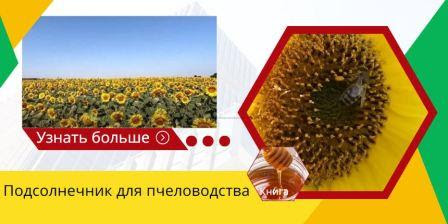Linden heart-shaped Linden small-leaved - honey plants
Linden heart-shaped Linden small-leaved - honey plants Linden heart-shaped, (Lime small-leaved) - lat. T?lia cord?ta is a tree widespread in Europe and Western Asia; species of the genus Linden of the Malvaceae family. Deciduous tree 20-38 m tall with a hipped crown.
The bark is dark, furrowed on older trees.
The leaves are alternate, heart-shaped, long-petiolate, serrated, with a drawn pointed apex, green above, bluish below.
The flowers are regular, bisexual, with a double five-parted perianth, up to 1-1.5 cm in diameter, yellowish-white, fragrant, collected in drooping corymbose inflorescences of 3-11 pieces, with inflorescences there is an oblong yellowish-green stipules. There are many stamens in the flower.
...
.
...
Blooms from early July 10-15 days. The nectar-bearing tissue, located on the inside of the bases of the sepals, secretes 5-10 mg of nectar. The honey productivity of linden plantations reaches 800–1000 kg/ha. During flowering in places of its mass growth, bee colonies collect up to 10-14 kg of honey per day.
Linden honey has long been considered the best in terms of taste and healing qualities.
Linden honey in a liquid state is colorless or slightly yellowish, transparent. After crystallization, it turns into a yellowish or light amber mass of a dense, greasy (fine-grained) consistency. There is linden honey and coarse-grained crystallization (depending on the type of linden and storage conditions). The taste is quite spicy, very sweet. It has a delicate, pleasant aroma of linden flowers. Linden honey contains 35.6% glucose, 5% dextrins and 3.2% sucrose. Crystallizes after 7 months. It is widely used in medical and dietary nutrition. It has a pronounced anti-inflammatory, diaphoretic, antipyretic and diuretic effect. They successfully treat colds, tonsillitis and stomatitis. In folk medicine, this honey is used for various diseases of the gastrointestinal tract, liver and kidneys. It has a general strengthening and calming effect. It is also recommended for rheumatism, fainting, pneumonia, as an anti-measles agent, for mumps and convulsions in children, as an anti-inflammatory, analgesic and emollient for burns, eczema, inflammation of the mammary glands and other inflammatory processes. In a mixture with propolis, linden honey is used for pain in the urethra, urinary and cholelithiasis, and with goat's milk - for pulmonary tuberculosis.
Pollen grains are three-furrowed, spherical-flattened shape. The length of the polar axis is 25.5–28.9 µm, the equatorial diameter is 32.3–35.8 µm. Almost round in outline from the pole, elliptical from the equator. The furrows are slit-like, short, visible only under an immersion lens. The ora are longitudinally elongated, with uneven edges, deeply submerged, with a maximum diameter of 10.5–11 µm; orovaya membrane smooth or fine-grained. Mesoporium width 23.5–28.1 µm. The thickness of the exine in the center of the mesoporium is 2.2 µm, about op 8 µm; the upper layer of the exine, slightly wedging out, covers the ora. The rod layer is 0.8–1 µm thick, the rods are straight or knotted, with rounded or flattened heads. The cells are angular or oval, formed as a result of the fusion of the walls of the rods or their heads; the largest cell diameter is 1.2 µm, the smallest is 0.5 µm. The color of pollen is light yellow-green.
The fruit is a spherical, pubescent, thin-walled, one- or two-seeded nutlet. The fruits ripen in August - September.
The flowers contain an essential oil, the smell of which is due to the presence of farnesol alcohol, hesperidin and tiliacin glycosides, saponins, tannins, carotene, ascorbic acid, sugars; bracts - mucus and tannins; fruits - fatty oil (in peeled fruits - up to 58%), close in quality to Provence, and in taste - to almond or peach; the bark contains the triterpenoid tiliadin; in the leaves - carotene, ascorbic acid, mucus, over 12% carbohydrates.
Pharmacological properties
Lime blossom (flowers and bracts) is used as a flavoring agent in the perfume industry, in the production of cognacs and liqueurs, and also as a tea substitute. Rich in starch, sugars and vitamins, young leaves and blossoming buds are eaten in spring, salads are prepared from them, and pickled.
The use of linden in folk medicine
Lime blossom has anti-inflammatory, diaphoretic, soothing, antipyretic and diuretic effects. In medicine, it is used for colds as a diaphoretic and antipyretic, as well as a bactericidal for rinsing the mouth and throat.
Linden tea - an infusion of dried flowers - is used in folk and scientific medicine for inflammatory diseases of the respiratory system, tuberculosis, pyelonephritis, cystitis, urolithiasis, rheumatism, as an antitussive, for migraine, epilepsy, influenza and tonsillitis, mumps and measles, atherosclerosis and sugar diabetes, with gastrointestinal colic; externally, linden flowers are used to strengthen hair, and crushed buds, leaves and flowers are used as an emollient.
stvo for compresses with furunculosis. Linden cambium is used by the people for burns, hemorrhoids, mastitis, gout, and crushed seeds - as a hemostatic. Linden tar is smeared with eczema-affected areas. Wood in a calcined, finely ground form is used for flatulence, poisoning. Lime blossom is used in cosmetics to soften, cleanse the skin and reduce sweating.
The heart-shaped linden is a beautiful park tree, which has long been used for the construction of alleys and groves.
As a honey plant, it has no equal in the domestic flora, it gives the most valuable, fragrant honey. Better honey yields on fertile and permeable soil in an open location.


Комментариев нет:
Отправить комментарий